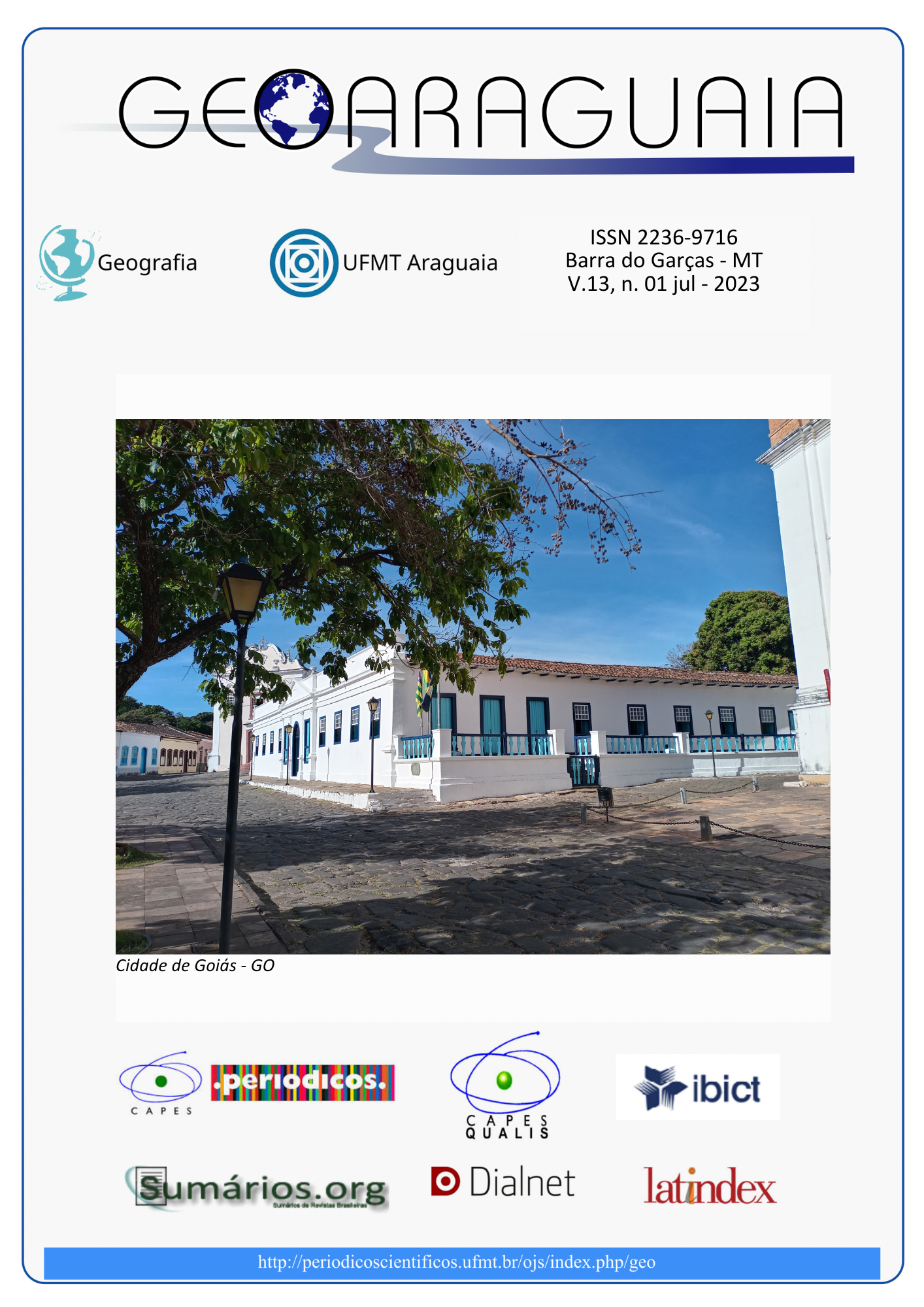Mapping Murundus Fields in the Rio Claro Basin (MG) Using Google Earth Engine
Keywords:
Wetlands, Random Forests, Sentinel-2, Red-edgeAbstract
Wetlands are transition zones between aquatic and terrestrial environments that are home to several animal and plant species, providing several ecosystem services. Murundus fields are typical wetlands of the Brazilian Cerrado, with an important role in local biodiversity and water regime. The present study aimed to detect the murundus fields in the Claro river basin (MG) using Sentinel 2 satellite images. For this, the Google Earth Engine platform was used to implement an algorithm based on machine learning (Random Forests) aiming to map the study area from four distinct combinations of input data. The results indicate that the joint use of all Sentinel-2 bands and the normalized difference water index was the most efficient, presenting 71.95% producer accuracy, 79.42% user accuracy and F-measure of 75.5%. Furthermore, it is observed that the combination of the near-infrared and red-edge bands result in a satisfactory F-measure index (69.39%), indicating that these spectral regions provide important information to detect wetlands. The development of technologies that assist in the detection and monitoring of murundus fields can aid in the preservation of these habitats. Due to its processing in the cloud, GEE has the potential to map wetlands over large areas.
References
AMANI, M.; SALEHI, B.; MAHDAVI, S.; BRISCO, B. Spectral analysis of wetlands using multi-source optical satellite imagery. ISPRS Journal of photogrammetry and remote sensing, v. 144, 119-136, 2018. DOI: https://doi.org/10.1016/j.isprsjprs.2018.07.005.
BREIMAN, L. “Random Forests”. Machine Learning. 2001. doi:10.1023/A:1010933404324.
ARAÚJO NETO, M. D.; FURLEY, P. A.; HARIDASAN, M.; JOHNSON, C. E. The murundus of the cerrado región of Central Brazil. Journal of Tropical Ecology, v. 2, n. 1, p.17-35, 1986.
ESQUERDO, J. C. D. M.; ANTUNES, J. F. G. Monitoramento temporal de variáveis espectrais em áreas do pantanal utilizando dados AVHRR/NOAA-17. Revista Brasileira de Cartografia, v. 62, n. 4, 11. 2010.
CUNHA, C. N. C.; PIEDADE, M. T. F.; JUNK, W. F. Classificação e delineamento das áreas úmidas brasileiras e de seus macrohabitats. Instituto Nacional de Ciência e Tecnologia em Áreas Úmidas – INAU. – Cuiabá: EdUFMT, 2015.
FURLEY, P. A. Classification and distribution of murundus in the cerrado of Central Brazil. Journal of Biogeography, p. 265-268, 1986.
GIBBS, James P. Wetland loss and biodiversity conservation. Conservation biology, v. 14, n.1, p. 314-317, 2000.
GOOGLE. Google Earth website. http://earth.google.com/, 2022.
GOMES, C. S.; MAGALHÃES JÚNIOR, A. P. Sistemas de classificação de áreas úmidas no brasil e no mundo: panorama atual e importância de critérios hidrogeomorfológicos. Geo UERJ, Rio de Janeiro, n. 33, 2018. DOI: https://doi.org/10.12957/geouerj.2018.34519.
HARDY, A.; OAKES, G.; ETTRITCH, G. Tropical Wetland (TropWet) Mapping Tool: The Automatic Detection of Open and Vegetated Waterbodies in Google Earth Engine for Tropical Wetlands. Remote Sensing, v. 12, n. 7, 2020. DOI: https://doi.org/10.3390/rs12071182.
HIRD, J. N.; DELANCEY, E. R.; MCDERMID, G. J.; KARIYEVA, J. Google Earth engine, open-access satellite data, and machine learning in support of large-area probabilistic wetland mapping. Remote Sensing, v. 9, n. 12, dezembro, 2017. DOI: https://doi.org/10.3390/rs9121315.
INSTITUTO MINEIRO DE GESTÃO DAS ÁGUAS (IGAM). Outorga de lançamento de efluentes na Bacia do Ribeirão da Mata. Instituto Mineiro de Gestão das Águas. Belo Horizonte. 2013.
JUNK, W. J.; PIEDADE, M.T.F; LOURIVAL, R; WITTMANN, F; KANDUS, P; LACERDA, L.D; BOZELLI, R.L; ESTEVES, F.A; CUNHA, C.N; MALTCHIK, L; SCHÖNGART, J; SCHAEFFER-NOVELLI, Y; AGOSTINHO, A.A. Brazilian wetlands: their definition, delineation, and classification, for research, sustainable management, and protection. Aquatic Conservation: Marine and Freshwater Ecosystems, v. 24, n. 1, 5-22, 2013. DOI: https://doi.org/10.1002/aqc.2386.
KAPLAN, G.; AVDAN, U. Evaluating Sentinel-2 Red-Edge Bands for Wetland Classification. Proceedings, v. 18, n. 1, 2019. DOI: https://doi.org/10.3390/ECRS-3-06184.
MAHDIANPARI, M.; SALEHI, B.; MOHAMMADIMANEH, F.; HOMAYOUNI, S. E.; Gill, E. The first wetland inventory map of newfoundland at a spatial resolution of 10m using Sentinel-1 and Sentinel-2 data on the Google Earth engine cloud computing platform. Remote Sensing, v. 11, n. 1, dezembro, 2018. DOI: https://doi.org/10.3390/rs11010043.
MAHDIANPARI, M.; JAFARZADEH, H.; GRANGER, J. E.; MOHAMMADIMANESH, F.; BRISCO, B.; SALEHI, B.; HOMAYOUNI, S.; WENG, Q. A large-scale change monitoring of wetlands using time series Landsat imagery on Google Earth Engine: a case study in Newfoundland. GIScience & Remote Sensing, v. 57, 1102-1124, 2020. DOI: https://doi.org/10.1080/15481603.2020.1846948.
PONZONI, F.J.; SHIMABUKURO, Y.E. Mistura Espectral modelo linear e aplicações. Oficina de Textos. São Paulo – SP, 2017.
RADOUX, J.; BOGAERT, P.; FASBENDER, D.; DEFOURNY, P. Thematic accuracy assessment of geographic object-based image classification. Int. J. Geogr. Inf. Sci, 25, 895–911. 2011.
RAMOS, M. V. V.; HARIDASAN, M.; ARAÚJO, G. M. Caracterização dos solos e da estrutura fitossociológica da vegetação de veredas da chapada do Triângulo Mineiro. Fronteiras: Journal of Social, Technological and Environmental Science, v. 3, n. 2, p. 180-210, 2014.
SILVA, A. G. P.; CREMON, E. H.; BOGGIONE, G. A.; ALVES, F. C. Integração de imagens orbitais ópticas e SAR com processamento em nuvem no mapeamento da cobertura da terra no Cerrado. Revista Geoaraguaia. v.11 n. Esp. Geotecnologias p. 85- 106. Ago-2021.
VALENTI, V.; CARCELEN, E. C.; LANGE, K.; RUSSO, N. J.; CHAPMAN, B. Leveraging Google Earth Engine User Interface for Semiautomated Wetland Classification in the Great Lakes Basin at 10 m With Optical and Radar Geospatial Datasets. IEEE Journal of selected topics in applied earth observations and remote sensing, v. 13, 6008-6018, 2020. DOI: 10.1109/JSTARS.2020.3023901.
Downloads
Published
How to Cite
Issue
Section
License
A Revista Geoaraguaia poderá solicitar alterações de ordem normativa, ortográfica e gramatical, com vistas a manter o padrão culto da língua. Se necessário, alguns ajustes normativos podem ser feitos pela revista, porém respeitando o estilo dos autores.
As provas finais não serão enviadas aos autores.
As opiniões emitidas pelos autores dos artigos são de sua exclusiva responsabilidade.





 A revista
A revista